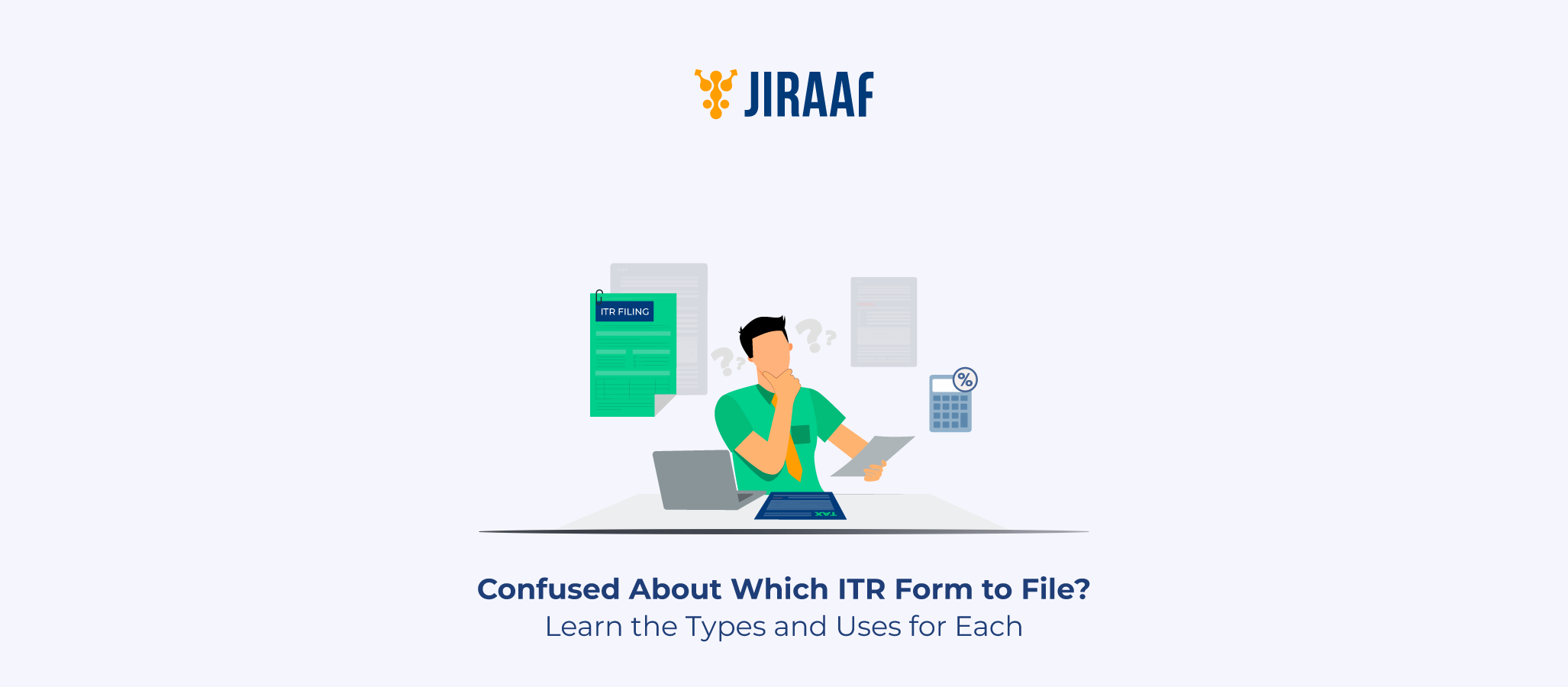In order to provide information about their income, deductions, and tax obligations for a specific fiscal year, Indian taxpayers are required to submit an Income Tax Return (ITR) form to the Income Tax Department. It acts as a record of your earnings, the taxes paid, and any other owed refunds for a person or organization. To date, the income tax department has issued seven forms: ITR-1, ITR-2, ITR-3, ITR-4, ITR-5, ITR-6, and ITR-7. It is essential that you submit the ITRs before the set deadline. ITR forms are applicable in many ways, depending on the taxpayer’s income sources, income amount, and tax-paying category (individuals, HUF, firm, etc.).
What Is an ITR Form, and Why Does it Matter?
The ITR is a form that citizens submit to the income tax department outlining their income and any applicable necessary taxes.
Since each ITR form is meant for a certain source of income (such as a salary, business, or investments), choosing the right form is very important. Rejection, fines, or lost tax benefits can result from filing the wrong ITR form.
For example, if you own a business, you must file ITR-3 or ITR-4, whereas if you are a salaried citizen, you can file the ITR-1. By maximizing the allowable deductions and ensuring correct tax compliance, using the appropriate form helps prevent probable legal problems. Always verify the most recent tax laws or, if in doubt, get advice from a trusted expert.
You can claim a tax refund if you have overpaid taxes, report foreign income or investments as required by law, and improve your credit score when you apply for loans or visas by submitting your ITR. Regardless of profit or loss, filing ITR is a necessity for businesses and firms.
Also, filing your ITR on time (by 15th September 2025 for individuals not requiring audit) guarantees that you can carry forward any business or capital losses you may have in order to make up for future earnings; this benefit is taken away if you do not file your returns on time. Therefore, filing ITR protects your tax benefits, opens financial opportunities, and helps you avoid tax penalties.
Which ITR Form Applies to Whom?
Proper tax compliance requires you to file the appropriate ITR form. Your occupation, financial activities, and sources of income will determine the form you need to file. You can use the quick reference chart below to determine which ITR form is appropriate for you based on your taxpaying category.
| Taxpayer Category | Applicable ITR Form | Key Conditions | Exclusions |
| Salaried individuals | ITR-1 (Sahaj) | Income up to ₹50 lakh from salary/pension, one house property, other sources; capital gains up to ₹1.25 lakh allowed | Not for NRIs, capital gains, multiple properties, or income from a business. |
| Business owners (presumptive taxation) | ITR-4 (Sugam) | Income under sections 44AD, 44ADA, or 44AE, turnover of up to ₹2 crore for business or ₹50 lakh for profession | Not for directors, NRI |
| Freelancers, consultants | ITR-3 or ITR-4 | ITR-3 for actual income computation, ITR-4 for presumptive taxation under section 44ADA | Not for individuals using presumptive taxation methods |
| Pensioners, retirees | ITR-1 or ITR-2 | ITR-1 if income up to ₹50 lakh and no capital gains, ITR-2 if income exceeds ₹50 lakh or has capital gains | Not for NRIs, capital gains, or those with income from business or profession |
| Agriculture income holders | ITR-2 or ITR-3 | ITR-2 if no business income, ITR-3 if combined with business income | Not for those with income from business or profession or individuals using presumptive taxation |
| Partnership firms and LLPs | ITR-5 | For firms and LLPs not claiming exemptions under section 11 | Not for individuals or companies |
| All income types for companies | ITR-6 | Companies other than those claiming exemption under Section 11 | Excluding those claiming exemption under section 11, not for charitable/religious institutions |
| Entities claiming exemption under Sections 139(4A) to 139(4F) | ITR-7 | Trusts, political parties, research institutions, etc. | Not for companies or firms not covered under those sections |
Make sure you file the correct form because choosing the wrong one could result in rejection, penalties, or even notices from the income tax department.
ITR Forms Based on Income Source
Your principal sources of income, such as your salary, business profits, capital gains, or pension, all have a significant impact on which ITR form you need to file. To guarantee correct tax filing and compliance, the income tax department has assigned specific forms for various income categories.
Choosing the appropriate form guarantees that you claim the relevant deductions as well as advantages in addition to preventing penalties. The ITR forms that apply to each of the main sources of income are broken down below.
ITR Form for Salaried Individuals
- ITR-1 (Sahaj): Applicable for citizens with income of up to ₹50 lakh from salary/pension, one house property, and other sources (excluding lottery winnings and racehorses). Capital gains up to ₹1.25 lakh allowed.
- ITR-2: For individuals with income exceeding ₹50 lakh or having capital gains.
ITR Form for Business Income
- ITR-3: For individuals and HUFs with income from business or profession.
- ITR-4 (Sugam): For individuals, HUFs, and firms (other than LLPs) opting for presumptive taxation under sections 44AD, 44ADA, or 44AE with turnover up to ₹2 crore for business or ₹50 lakh for profession. Capital gains up to ₹1.25 lakh allowed.
ITR Form for Freelancers & Consultants
- ITR-3: For freelancers with income from profession or business under actual income computation.
- ITR-4: For freelancers opting for probable taxation under section 44ADA.
ITR Form for Pensioners and Retirees
- ITR-1 (Sahaj): For pensioners with income up to ₹50 lakh and no capital gains.
- ITR-2: For pensioners with income exceeding ₹50 lakh or having capital gains.
ITR Form for Agriculture Income Holders
- ITR-2: For citizens with agricultural income exceeding ₹5,000 and no business income.
- ITR-3: For individuals with agricultural income and business income.
ITR Form for Partnership Firms and LLPs
- ITR-5: Applicable to partnership firms and LLPs not claiming exemption under section 11.
How to Download the Correct ITR Form
- Visit the official income tax e-filing portal https://www.incometax.gov.in/
- Find the ‘Downloads’ section.
- Select the correct assessment year (e.g., AY 2025–26).
- Choose the relevant ITR form and download the utility (Excel or Java).
Common Mistakes to Avoid When Choosing an ITR Form
The tax officials can delay, reject, or even penalize you if you choose the wrong ITR form. Many people make mistakes while submitting their ITR form, such as choosing a form that isn’t appropriate for their sources of income, failing to include foreign assets, or failing to meet loss carry-forward deadlines.
Here are some common mistakes to avoid in order to ensure a smooth filing process.
- Missing the ITR deadline. For AY 2025-26, the last date to file ITR for individuals/HUF/AOP/BOI (not requiring audit) is 15th September 2025, extended from the original 31st July 2025. Filing late can attract penalties up to ₹5,000 and interest under Sections 234A and 234F.
- Not pre-validating your bank account. Make sure that your bank account is pre-validated, or the refund can be held up and lead to further complications.
- Selecting the wrong ITR form. Choosing the wrong form can lead to defective return notices.
- Not reporting all income sources. Omitting income can attract tax notices and penalties later on.
- Not verifying form 26AS and AIS (Annual information statement). Always match your ITR form with form 26AS and AIS before submitting to avoid mismatches and delays in refund.
- Claiming fake deductions. Filing fake rent receipts for HRA (house rent allowance) or false deduction claims may lead to penalties and legal action.
- Skipping ITR verification. Filing ITR isn’t the final step; you need to verify it as well. If not verified, your returns will be treated as invalid.
FAQs on Choosing ITR Form
Which ITR forms are for salaried and capital gains?
The various ITR forms that apply to salaried individuals are as follows:
ITR-1: A person can submit an ITR-1 if their total annual income is less than ₹50 lakhs and they only receive revenue from one residential property.
ITR-2: A person can file an ITR-2 if they receive income from more than one residential property, have capital gains income, or earns more than ₹50 lakh.
ITR-3: If a person receives income from a business or profession in addition to their salary, they may file an ITR-3.
ITR-4: People can file an ITR-4 form if they are receiving a salary in addition to extra money from part-time work or freelancing.
How to file ITR myself?
- Gather all the needed documents, including your Form 16.
- Choose the right ITR form based on your income and other factors.
- Register or log in to the e-filing portal on the official income tax website.
- Fill out your ITR form with the right details.
- Review and submit your ITR.
- Pay any outstanding tax if applicable.
- Download and save your acknowledgment.
What is the basic exemption limit for AY 2025-26?
₹4 lakh under the new tax regime for all individuals irrespective of age.
Who is eligible to opt for a presumptive taxation scheme for filing ITR-4?
The point of the presumptive taxation plan is to relieve small taxpayers with a turnover of less than ₹2 crore of the burden of keeping large track of their accounts. Under this plan, the total turnover is used to calculate the taxable income at a set rate.
ITR tax exemption limit?
For AY 2025-26, the basic exemption limit under the new tax regime is ₹4 lakh, applicable to all individuals irrespective of their age.
What documents do I need to file along with ITR-1?
You are not required to submit any documents while filing the ITR-1. However, to properly complete the ITR submission, it is advised to download AIS and Form 16, as well as any applicable house rent receipts, investment payment receipts, and premium receipts.
Discover fixed income investments with Jiraaf, a SEBI registered online bonds platform that educates and brings access to a wide array of bonds. Sign up today to explore diversified fixed income investment opportunities to support your goal-based wealth creation journey. Start investing!



